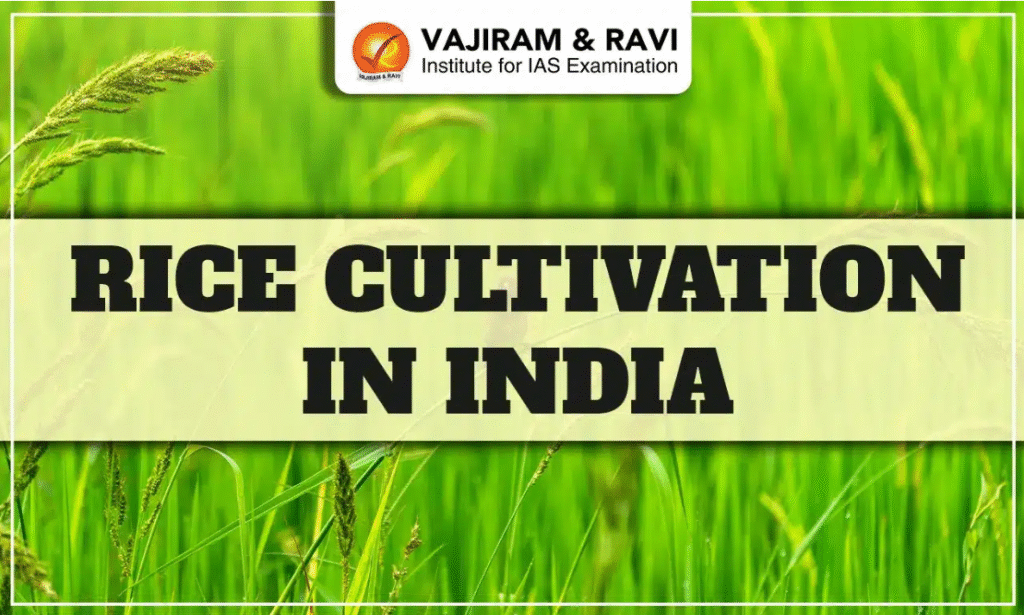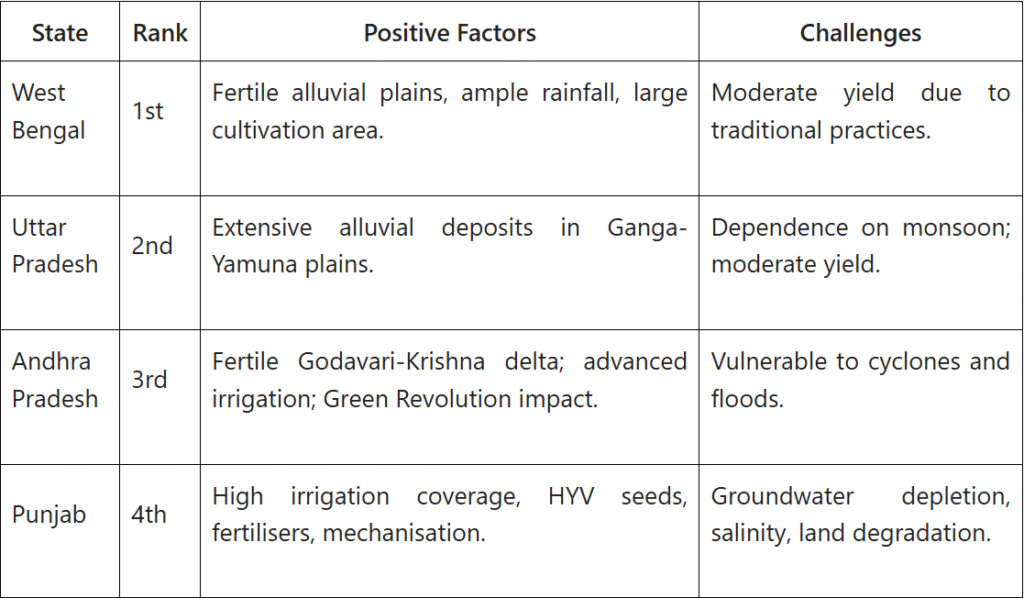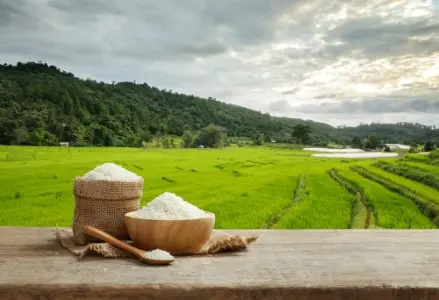Tags
Rice Cultivation in India, Map, Requirement, Methods, Growth
Know about rice cultivation in India including its types, growth seasons, ideal climate, major producing states, production trends, and global export details
By Prafulla Vats

Rice is an integral component of India’s dietary and agricultural identity. As the staple food for the majority of the Indian population, it occupies a central position not only in daily consumption but also in the nation’s agricultural economy. India stands as the second-largest producer of rice in the world, after China, and simultaneously holds the position of being the largest exporter of rice globally. In this article, we are going to cover rice cultivation, its types, growth seasons, climate conditions, production and productivity as well as the trade and export of rice.
Rice Cultivation in India
Rice cultivation in India is not just an agricultural activity. It is a cultural, economic, and ecological cornerstone. The country’s consistent position as a leading producer and exporter demonstrates its agricultural strength and global significance. However, challenges like water scarcity, soil degradation, declining productivity, and climatic variability demand innovative and sustainable interventions. Practices like SRI and DSR, coupled with improved irrigation efficiency, organic inputs, and technology-driven farming, hold the key to a resilient future for India’s rice sector.
About Rice
Rice forms the dietary backbone of India. A significant proportion of the population, especially in eastern, southern, and north-eastern regions, depends on rice as their staple food. The crop is deeply interwoven with India’s socio-economic structure, rural livelihoods, and cultural traditions.
Being a Kharif crop, rice requires high temperatures (above 25°C), high humidity, and annual rainfall exceeding 100 cm for optimum growth. However, with irrigation facilities, it can also thrive in areas with lower rainfall. It is most commonly cultivated in states such as West Bengal, Uttar Pradesh, Punjab, Andhra Pradesh, Tamil Nadu, Bihar, Odisha, and Assam.
Unpolished rice has a higher nutritional value, being rich in Vitamins A, B, and calcium, whereas polished rice loses much of these essential nutrients during milling. Besides its nutritional importance, rice cultivation also supports mixed farming systems, integrating crops and livestock to enhance sustainability and income.
Types of Rice
Rice varieties are diverse, catering to different tastes, climates, and culinary preferences. Broadly, rice can be classified into three major categories based on grain size:
- Long-grain rice: Varieties like Basmati and Jasmine rice fall under this category. They are slender, aromatic, and become fluffy when cooked.
- Medium-grain rice: Examples include Arborio and Calrose rice. These grains are shorter and have a tender, moist texture.
- Short-grain rice: Varieties like Japanese sushi rice and glutinous rice are plump and sticky.
In addition to these, there are specialty varieties:
- Brown rice, which retains its bran layer, making it more nutritious and fiber-rich.
- Black rice, known for its high antioxidant content and striking color.
- Wild rice, technically a grass seed, with a nutty flavor and chewy texture.
Each type contributes uniquely to culinary traditions worldwide, reinforcing rice’s versatility and global importance.
Rice Crop Seasons
Rice is primarily a Kharif crop, grown during the southwest monsoon season (June to October). However, due to India’s diverse agro-climatic conditions, it can also be cultivated in Rabi and Summer seasons under assured irrigation.
- Kharif Season: The main rice-growing period, where sowing begins with the onset of the monsoon (June-July) and harvesting takes place between October and December.
- Rabi Season: In well-irrigated areas, particularly in southern and eastern India, rice is cultivated during the Rabi season (November–April).
- Summer Crop: Found mainly in deltaic regions such as West Bengal and the Krishna-Godavari delta, where water availability throughout the year permits multiple cropping cycles.
Thus, India’s rice cultivation calendar allows for two to three crops per year in regions with abundant water, supporting high agricultural productivity and rural employment.
Rice Climatic Conditions for Growth
Rice is a tropical crop that thrives under hot and humid conditions. The ideal temperature range for rice cultivation is between 25°C and 35°C, along with annual rainfall exceeding 150 cm.
In eastern and southern India, where humidity and warmth prevail for much of the year, farmers can cultivate rice two or even three times annually. In contrast, northern and hilly regions can only support one crop per year due to the onset of cold winters.
A defining feature of rice cultivation is its semi-aquatic nature. The crop requires standing water (10-12 cm deep) during most of its growing season. The waterlogged condition helps control weeds and ensures nutrient availability.
Rice can be categorized based on topography and water availability:
- Wet or Lowland Rice: Grown in flooded plains with ample rainfall or irrigation (e.g., Indo-Gangetic plains, coastal deltas).
- Dry or Upland Rice: Cultivated in areas with less rainfall or on terraced slopes (e.g., north-eastern hills).
- Below-Sea-Level Cultivation: Unique to the Kuttanad region of Kerala, where rice is grown on reclaimed land below sea level using special bunds.
The 100 cm isohyet marks the natural limit for rainfed rice cultivation. However, irrigation advancements have enabled cultivation even in regions like Punjab, Haryana, and Western Uttar Pradesh, where rainfall is relatively scarce.
Rice Soil Requirements
Rice cultivation is best suited to clayey or loamy soils found in river valleys, floodplains, deltas, and coastal regions, where water stagnation is possible.
- Clayey soils possess excellent water-holding capacity, making them ideal for lowland rice in areas such as coastal Tamil Nadu, Karnataka, and Telangana.
- Loamy soils, found in the Punjab, Haryana, and North Indian plains, require more frequent irrigation due to lower water retention.
Rice can tolerate a wide pH range, growing in both acidic and alkaline soils, which broadens its geographical adaptability.
Rice Cultivation Labour Requirement
Rice remains a labour-intensive crop, particularly in traditional cultivation methods. From nursery preparation and transplanting to weeding and harvesting, each stage demands substantial manual labour. Hence, rice cultivation is concentrated in densely populated areas where human labour is readily available.
In mechanized regions like Punjab and Haryana, the labour demand is met through migrant workers from Bihar and eastern Uttar Pradesh, ensuring timely sowing and harvesting.
Methods of Rice Cultivation
India has remarkable diversity in its rice cultivation techniques, adapted to varying topographies, climates, and resource availability.
- Broadcasting Method: Seeds are sown by hand directly over dry soil. This method is simple and suitable for areas with low fertility or labour shortages, but yields are relatively low.
- Drilling Method: Involves ploughing and simultaneous sowing of seeds. Practised mainly in dry regions of peninsular India, this technique provides better soil contact than broadcasting but remains less productive.
- Transplantation Method: The most widely used and effective method in India. Seeds are first raised in nurseries, and the seedlings (about 25–30 days old) are transplanted to the main field. Though labour-intensive, it ensures better plant spacing, weed control, and high yields.
- Japanese Method: A mechanised and scientific technique involving the use of machines for transplanting, fertilising, and weeding. Heavy doses of fertilisers are used, achieving very high productivity. While common in developed countries, it is limited in India due to small farm sizes.
- System of Rice Intensification (SRI): A modern innovation promoting sustainable rice farming. In SRI, young seedlings are planted singly at wider spacing, soil is kept moist but not flooded, and organic manure is used instead of chemical fertilisers. The method enhances root growth, reduces water use, and increases yield. SRI is not a fixed technique but a flexible approach that optimizes land, water, and labour efficiency.
- Direct Seeding of Rice (DSR): An emerging technique where seeds are directly sown in the field using drills, eliminating the need for transplanting. DSR reduces labour and water usage and shortens the crop cycle, making it suitable for water-scarce regions like Punjab and Haryana
Rice Production and Productivity in India
India contributes about 20% of global rice production, showing its important role in ensuring both domestic and international food security. According to recent data, India’s average rice yield is around 2.7 tonnes per hectare, which, though improving, remains below the global average of 4.3 tonnes per hectare. Leading rice producers like China (6.5 tonnes/ha), Australia (10 tonnes/ha), and the United States (7.5 tonnes/ha) outperform India due to advanced technologies and better resource management.

Other significant producers include Tamil Nadu, Bihar, Odisha, Chhattisgarh, Assam, and Telangana, each contributing substantially to national production.
Rice Cultivation in India Map
Here is a geographical representation of rice growth in India:
Rice Trade and Export in India
India holds the top position in global rice exports, surpassing Thailand since 2011–12. The country exports both basmati and non-basmati rice, catering to diverse global markets.
Basmati rice, known for its aroma and long grain, is primarily cultivated in Punjab, Haryana, and western Uttar Pradesh. Major importing nations include Saudi Arabia, Iran, Iraq, and Yemen.
India’s competitive advantage lies in its vast production base, cost-effective labour, and diversified rice varieties that meet global demand preferences.
System of Rice Intensification (SRI)
The System of Rice Intensification (SRI) showed a transformative shift in rice cultivation. Originating in Madagascar, SRI principles emphasize reduced water use, younger seedlings, wider spacing, and organic inputs. The system enhances root development, soil aeration, and microbial activity, leading to higher productivity even under resource constraints.
SRI aligns with India’s sustainable agriculture vision, offering solutions to challenges like water scarcity, soil degradation, and climate change.
Direct Seeding of Rice (DSR)
The Direct Seeding of Rice (DSR) method involves sowing seeds directly into the field using seed drills, thus avoiding transplanting. This approach conserves 30- 40% water and reduces labour costs significantly. It also shortens the crop duration, facilitating timely sowing of subsequent crops such as wheat.
With growing water scarcity in north-western India, DSR is emerging as a viable alternative to traditional paddy cultivation, though it requires proper weed management and suitable soil conditions for best results
https://vajiramandravi.com/current-affairs/rice-cultivation-in-india/Published Date: October 10, 2025






